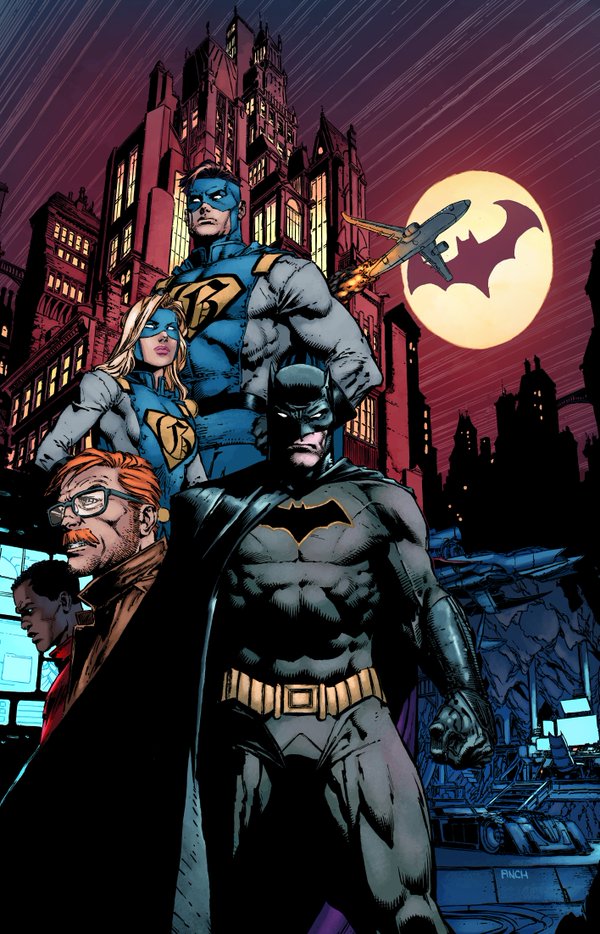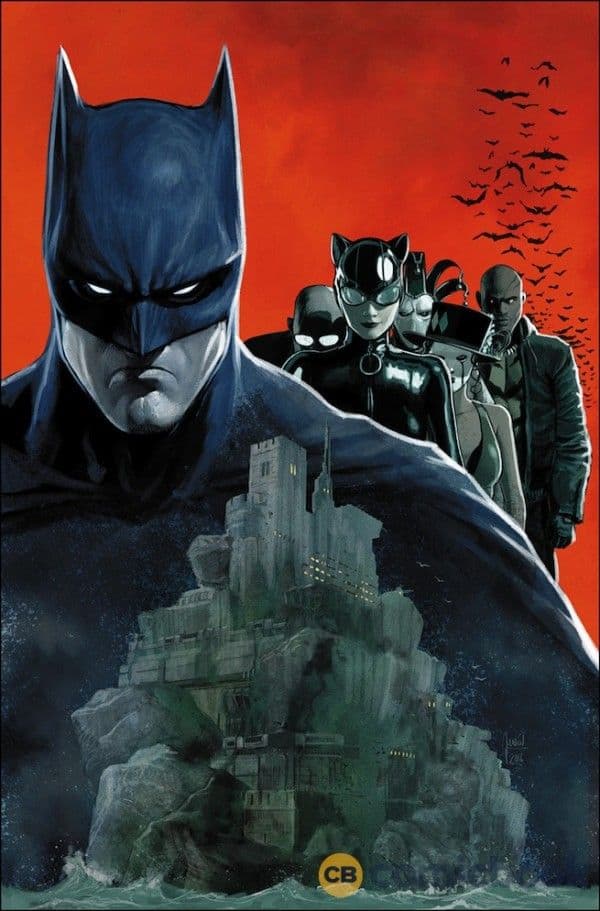Like a lot of people I am a huge fan of Batman. I also breath air and have skin. I grew up with Batman, I read a lot of Batman, seen all the movies-because apparently that's a qualifier-and when DC Rebirth rolled along I was ready to hop aboard the Batman train.
Currently there are two Batman books I read: Batman, and Detective Comics (which is much better). But when I learned one of my favorite writers-Tom King-was going to be taking over Batman I was very excited. Needless to say I'm a bit apprehensive now. So on today's Current Issues we're taking a look at Tom King's Batman arc-by-arc.
I Am Gotham

Tom King comes out swinging with an arc about two new characters-Gotham and Gotham Girl. Two young adults inspired by Batman to join the military and volunteer for some Superman-level experiment that gave them superpowers. This arc is all about the potential of superpowered people protecting Gotham City and the hope Batman has for their success. Batman actually believes they may replace him. However, due to the actions of Professor Hugo Strange and the villain Psycho Pirate, Gotham is driven to intense fear. And in the face of fear he snaps. Batman uses his car, his plane, his Justice League, and even Alfred in a Batsuit to defeat Gotham, but by the end it is Gotham's own sister Gotham Girl who overcomes her fears and fights him until his powers kill him. I sympathize with these two new characters, I like the way their powers work, and I like seeing Batman in a Justice League level problem. Gotham Girl becomes in interesting character, but it the last monologue in the book that worries me. The last bit of monologue basically tells us that years in future Gotham Girl will kill Batman and marry Duke Thomas-Batman's newest sidekick. This kicks off the idea that Batman's death could come sooner than we think.
I Am Suicide

Batman wants to undo the damage Psycho Pirate did to Gotham Girl and in order to do that he'll have to get The Pirate back-from Bane. Ruling over his prison island of Santa Prisca, Batman's longtime foe has been using Psycho Pirate to help him kick his addiction to the drug Venom. In order to breach Bane's defenses Batman negotiates with Amanda Waller and Jeremiah Arkham to assemble his own Suicide Squad consisting of Catwoman, Bronze Tiger, The Ventriloquist, and the duo Punch and Julie. Using this team he successfully defeats Bane and returns to Gotham with The Pirate. This arc stands to show how far Batman will go while also focusing on the pain that comes with the journey. The use of Batman's squad is pretty clever, but I can't help but feel there were better Batman characters to use here. I also enjoy the fact that Bane is kept in shadow, wearing nothing but briefs throughout the arc, this creates a sense of calmness Bane has over the situation. This is the arc that began my worries for this title. Batman basically admits in his monologue that becoming Batman was his form of suicide, that after the death of his parents he considered killing himself, but decided using Batman as a method of suicide is beneficial to everyone else. While one could see this as Batman overcoming suicide and seeing it as a positive message, I see this more as a macabre view of what Batman is. Batman should represent strength and overcoming of fear, Tom King's view is that the whole performance is just a less selfish for of suicide which really doesn't endear Batman's character.
I Am Bane

Bane suits up, grabs his Venom, and heads to Gotham with his posse to destroy Batman and get the Pirate back. After Batman's sidekicks are almost killed he sends them to stay in Superman's Fortress of Solitude. He then locks Alfred, the Pirate, and Gotham Girl in the basement of Arkham Asylum, gives every inmate their signature weapon, and leads Bane into the madhouse. Bane tears through every Batman villain big and small (except for The Joker) to get through the Asylum. Along the way he enforces the fact that he is not insane, he has no gimmick, and that he cannot be stopped and locked away. In their final confrontation Batman defeats Bane after he had tired out by Arkham's inmates. This arc compares Bruce to Bane, draws them as sick parallels to each other. One, born to fortune and driven by vengeance. The other, born in a prison and driven by survival. Two men trained physically and mentally, taught various forms of combat and strategy, destined to clash over and over. This story really helps rebuild Bane's profile and reminds readers why he is such a different threat to Batman. It is also in this story that Bruce comes near to death and talks to his mother on the other side. She tells Bruce he has more than proved his worth and that all the fighting should stop. But Bruce refuses. Again we see Batman skim against death, and yet again avoid his fate.
The War of Jokes & Riddles

If Batman has learned anything after his ordeal it is that life is short and staying Batman is a one way road to death. Between his near death experiences, his conversation with Gotham Girl, his dead mother, his father from another reality, and even Swamp Thing, Bruce Wayne is ready to make the steps towards building a better life even if it scares him. So he proposes to Catwoman. But before he can see what happens next Bruce feels the need to tell Selina a story he isn't proud of, a story that may change the way she looks at him. A few years into being a superhero, Batman stood between two forces of evil in a war for control of Gotham City. The Joker. The Riddler. And all the Batman villains they recruited. The War of Jokes and Riddles was fought on the grounds of who should kill Batman and the story portrays a battle of chaos and order. When Batman unites with Riddler they knock down Joker's men one by one until it's only the three of them and in the midst of battle The Riddler reveals he did all this to make The Joker laugh-which he hasn't the entire story. The Joker hasn't laughed, smiled, or enjoyed himself and strives to find something that will make him laugh. The Riddler believes Batman is too easy to figure out, and waged this entire war to try and make The Joker laugh. Batman tries to kill The Riddler, but The Joker stops him. The thought of Batman owing The Joker for preventing him from crossing his line makes The Joker finally laugh. Catwoman basically doesn't give a shit and they agree to get married. This was the arc that I hated the most. It interrupted a legitimately interesting premise, it portrayed Batman as either incredibly effective and/or incredibly irresponsible. How? Well, Batman is so good he can defeat both Deadshot and Deathstroke at the same time. Granted they had been fighting for five days. And if you think Deadshot can actually fight Deathstroke for more an hour, Tom, you are very, very wrong. Now here's where the real irresponsibility comes in. The Joker has this goon named Charlie Brown-no joke-and this guy helps Batman get dirt on The Joker. By involving himself in this war Charlie's son is poisoned and killed by The Joker and he becomes Kite Man. As Kite Man, Charlie slowly gets Joker's men captured and-in the end-helps get Riddler, Joker, and Batman alone. This man's life was destroyed because of Batman, this man is a criminal because of Batman, and this man's son is dead because of Batman. Oh, and remember how Bruce is telling Selina all this? Well, she was there for some of it, he even tells her the parts where she was there! The big "oh my god" moment? Of Batman deciding to kill Riddler and Joker stops him? That's surprising, that has potential, but I doubt anyone-including Tom King-will ever bring that up again. It's not big enough to warrant the drama, it's not big enough to warrant wasting seven issues of this title. Half of those issues are dedicated to exploring the joke character that is Kite Man who Tom King is really obsessed with for some reason. If this is a few years into Batman's career why is The Joker not laughing? Why does anyone know who he is? He looks as if he just stepped out of his "Killing Joke" origin story! And why is The Riddler buff and attractive? Like he stepped out of "Clockwork Orange"? Why is he super good at fighting? Why is he a weakling in "Zero Year" which happens before this story, buff in this story, and then back to being skinny in every story after this? By placing this in the past Tom King shoots his story in the foot by bringing up all these questions, he haphazardly handles how effective Batman is/isn't, and most importantly he interrupts his own successful setup for some drawn-out, annoyingly pompous, over-hyped, unfocused, high school lit-project of a story! He wastes time, money, and character potential by telling a story that will only be remembered as "that time all of Batman's bad guys were in the same story". The War of Jokes and Riddles was a dud and it was a dud that destroyed all momentum of this title and ruined the theme Tom had been using this entire time; the theme of death and retirement.
I will continue reading this title because we're finally moving on to Batman and Catwoman, but if you ask me I wouldn't recommend this title. Detective Comics is the best Batman book right now, it has great storytelling, great art, great character interactions, and it will give you everything you need to be a true Batman fan. But this title? Too bad to be a joke and too dumb to be a riddle.
Thanks for reading.
I will continue reading this title because we're finally moving on to Batman and Catwoman, but if you ask me I wouldn't recommend this title. Detective Comics is the best Batman book right now, it has great storytelling, great art, great character interactions, and it will give you everything you need to be a true Batman fan. But this title? Too bad to be a joke and too dumb to be a riddle.
Thanks for reading.
No comments:
Post a Comment